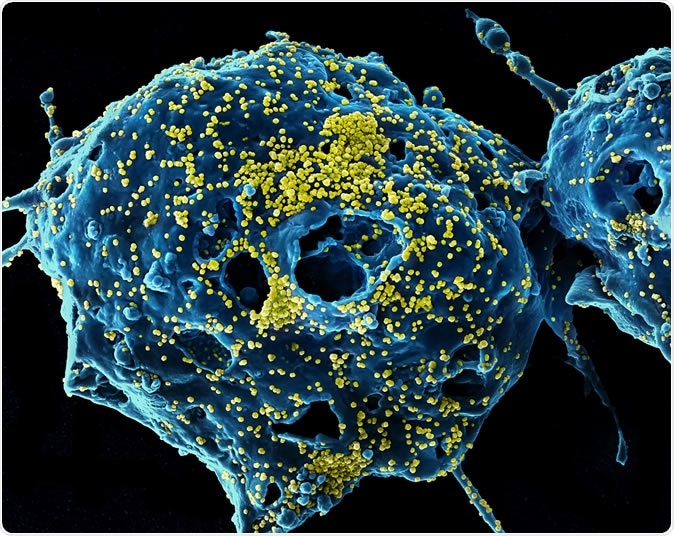The COVID-19 pandemic has affected almost all countries across the world, and India is no exception. Researchers have found that severe acute respiratory syndrome coronavirus 2 (SARS-CoV-2) has undergone several mutations with time.
The virus was first detected in Wuhan, Hubei province of China, in December 2019. Drs. Nidhan Biswas and Partha Majumder from the National Institute of Biomedical Genomics in Kalyani, West Bengal, India, are ready with their findings on the mutated version of the virus.
The findings are soon to be published in the upcoming COVID-19 issue of a peer-reviewed medical journal published by the Indian Council for Medical Research (ICMR) called the Indian Journal of Medical Research.

MERS Virus Particles Colorized scanning electron micrograph of Middle East Respiratory Syndrome virus particles (yellow) attached to the surface of an infected VERO E6 cell (blue). Image captured and color-enhanced at the NIAID Integrated Research Facility in Fort Detrick, Maryland. Credit: NIAID
What was this new study about?
Since its first detection in December 2019, the novel coronavirus or the SARS CoV-2 virus has been found to have undergone mutations and has at present 10 different strains.
One of these strains is A2a. This strain of the virus has infected the most number of people around the world.
This dominant strain, say researchers is extremely virulent and can infect human lung cells in huge numbers and quickly overwhelm the patient, especially those with underlying co-morbidities or other illnesses such as high blood pressure, diabetes, heart disease, respiratory disease, and renal disease.
What did the researchers do?
The researchers compared this new virus with its predecessor, the SARS virus, that led to the SARS outbreak in 2003. This outbreak had killed over 800 and infected 8,000 individuals and was also quite capable of infecting the lungs.
The A2a strain of SARS CoV-2, however, is more virulent the researchers said. They explained that the transmission rate of this new virus is an indication of how fast this new strain can move from one individual to another.
For this study, the team looked at the shared data from RNA sequencing from different nations. This data is available at the public database, GISAID freely shared by researchers across the world for the benefit of other researchers.
They collected 3636 RNA sequences of novel coronaviruses from 55 countries between December 2019 and April 6, 2020.
What did they find?
The researchers believe that their work will help the development of an efficient vaccine against this strain of the virus. Wuhan strain of the virus, they wrote was the “O” type of the virus. This new A2a strain is one of the ten mutations that originated from this original strain.
From the samples of the infection, the team looked at strains from 55 countries and India. From 55 nations they looked at 3,636 coronavirus RNA sequences. From these, they noted there were 50.8 percent or 1,848 samples containing the A2a strain. 580 sequences were showing the O strain and 505 sequences showing the B1 strain. From the 35 Indian RNA sequences checked, 47.5 percent or 16 were A2a strain and 13, 5, and 1 were A3, O, and B, respectively.
Majumder said in his statement, “It (A2a) has become the dominant type of SARS-CoV2.” Majumder, professor and founding director of NIBMG, said, “The coronavirus can be classified into many types --- O, A2, A2a, A3, B, B1, and so on. Currently, there are 11 types, including type O, which is the ‘ancestral type’ that originated in Wuhan.”
In Italy, 80 percent of the samples contain A2a strains, say reports. There is a predominance of this train in other nations such as the United Kingdom, the United States, Spain, Iceland, Congo, and Brazil. Since China has not submitted sequencing reporting after February 2020, the strains from China at present are not known.
Implications
Majumder explained, “To live, a virus must propagate by infecting other animals. A mutation usually disables the virus from transmitting itself.” However, not always does a mutation render a virus incapable of transmission, as has been seen here. The A2a strain originating from the O strain is more efficient in infecting humans. He said, “Such mutant viruses increase the frequency (of transmission) and sometimes completely replace the original type of the virus. The SARS-CoV-2 is doing just that.”
This new study on the RNA sequences also reveals that the A2a strain of the virus has altered its spike protein. In the earlier strains, the spike protein was the key to binding with the ACE2 receptors on the host cells that granted entry to the virus into the lung cells. In the A2a, the spike protein is altered so that it can bind more easily to the ACE2 receptors and thus allows it easier access to the lung cells. Majumder says that the reason behind the emergence of the pandemic is the easy infection capability of the A2a strain.

SARS-CoV-2 viruses are binding to ACE-2 receptors on a human cell, the initial stage of COVID-19 infection. Conceptual 3D illustration credit: Kateryna Kon / Shutterstock
The authors of the study agree that the Indian sample was only 35 sequences and was small in comparison to the international sequences. However, they still found around half of the sequences revealed A2a strain. These individuals also had no travel history abroad they wrote. They are calling for future studies looking at more samples from India to check if the A2a strain is indeed dominant here. They also said there was a need to explore the effects of genetic and ethnicities in the infection pattern, as was the effect of travel patterns among those infected.
Majumder said, “It’s unusual to see one single type sweeping through the world — but that’s what it looks like for the moment.”